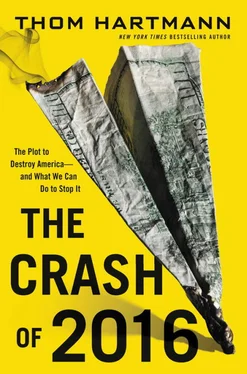And here’s another startling figure: The year Reagan was sworn into office, 1981, the United States was the largest importer of raw materials in the world and the world’s largest exporter of finished, manufactured goods. We brought in ores and shipped out everything from TVs and computers to cars and clothing. Today, things are totally reversed: We are now the world’s mining pit, the largest exporter of raw materials, and the world’s largest importer of finished, manufactured goods.
This has resulted in an enormous trade imbalance, one that has grown from a modest $15 billion deficit in 1981 to an enormous $539 billion deficit by 2012.
From 1791, when our nation’s first treasury secretary, Alexander Hamilton, created an eleven-point plan for American manufacturers, all the way until just the last few decades, the United States protected its manufacturing base with high tariffs on imports and government support for domestic industries.
This “protectionist” approach to trade transformed the United States into the world’s largest exporter of manufactured goods, which built and sustained an enormous middle class of Americans working in factories collecting high wages.
Then the forces of globalization crept in, extolling the virtues of a world economy free from national boundaries and protections for domestic manufacturing.
With the Reagan Revolution in the 1980s, Alexander Hamilton’s eleven-point plan, yet another pillar on which the middle class was built, was scrapped. In 1986, Reagan lowered tariffs. He also secured a free-trade deal with Canada in 1988. He vetoed protectionist trade bills throughout his presidency. And he doubled America’s spending in the global economy.
But Clinton really did a number on working people.
In the 1992 presidential debate, third-party candidate Ross Perot famously warned about a “giant sucking sound” of American jobs going south of the border to low-wage nations once trade protections were dropped.
Perot was right, but no one in our government listened to him.
Tariffs were ditched, and then Bill Clinton moved in to the White House in the 1990s. He continued Reagan’s trade policies and committed the United States to so-called free-trade agreements such as GATT, NAFTA, and the WTO, thus removing all the protections that had kept our domestic manufacturing industries safe from foreign corporate predators for two centuries.
In the 1960s, one-in-three Americans worked in manufacturing, producing things of lasting wealth. Today, after jumping headfirst into one free-trade agreement after another, only one in ten Americans works in manufacturing.
Over the last decade, fifty thousand manufacturing plants in the United States have closed down and 5 million manufacturing jobs have been lost. They didn’t disappear, they just moved away to low-wage factories, such as Foxconn, in foreign nations.
I saw the damage firsthand when I was returning home from a weekend trip to New York City on the Amtrak regional train that runs about hourly from Boston to Washington, DC. I was sitting in business class, looking out the window and talking on the phone with my old friend Earl Katz, an activist and documentary-film producer.
A few months earlier, while in Germany, I’d taken a long train ride from Frankfurt to Kulmbach, involving three changes of trains during the course of the four-hour trip. The German trains were new, gleaming, the interiors done in twenty-first-century plastic-and-teak paneling, the carpets quiet and elegant, the power seats highly adjustable with state-of-the-art audio. Even the bathrooms were elegant. And the train was traveling at well over one hundred miles an hour, and perfectly smooth.
The Amtrak train, on the other hand—even with the most expensive seat in the train—was old and decrepit. The bathroom was ancient in its technology, the tracks so rough that it was hard to walk from car to car without being pitched into some poor, unsuspecting person’s lap, the carpet and seats soiled, the doors between cars loud and clunky. And for much of the trip, the train was going between fifty and seventy miles an hour, and bumping, jerking, and screeching all over ancient and poorly maintained tracks.
But the most shocking difference was what I saw out the windows.
On my trip across Germany, I’d seen vibrant factories, towns where about a third of all the rooftops were covered with solar panels (Germany has gone from no solar power production to the point where home rooftop panels produce more power than ten nuclear reactors in less than a decade), gleaming modern office buildings (built to strict energy-saving standards), and everywhere the bustle of prosperity.
On the other hand, on my trip down the East Coast, I saw mile after mile of ancient, decrepit redbrick or cement factories that were covered in graffiti, cracking with weeds, dotted with boarded-up or broken windows looking at me like toothless old men staring unfocused out at the train through Salvation Army secondhand glasses.
Occasionally I could see the remnants of a name painted on the factory or etched into the concrete or brick rooflines or cornices, names that had been proudly put into place in the late nineteenth or early twentieth century. They spoke of the long-ago manufacture of steel and car parts and lawn mowers and machine tools, of sweaters and socks and jeans.
During one particularly poignant stretch, after passing dozens of empty factories the train passed what must have been at least a mile of empty houses. Most of them looked like they were formerly elegant brick row houses that, if they were in DC or New York today, would fetch a million dollars each. Yet these had once provided middle-class housing to the men and women who’d worked in the now-closed factories. Now they were mostly reduced to smashed-out windows, graffiti-tattooed walls, and rotting ceilings.
I was describing what I was seeing to Earl, who himself knew it all too well. “It looks like the end of America,” I said.
“It’s certainly the end of the American middle class,” Earl said in a soft, sad voice. “You can see it all across the country.”
This is the early stage of crash.
We’re not just talking about decaying railroads and buildings; we’re talking about decaying fundamentals—the pillars on which you can build a healthy economy, an expansive middle class, and a strong democracy.
All of it, sucked out of the country.
There was a moment of hesitation when Clinton signed the free-trade death warrant for the middle class.
According to Bob Woodward, during a meeting in the Oval Office regarding these trade deals, Clinton said sarcastically, “Where are all the Democrats? I hope you’re all aware we’re all Eisenhower Republicans.” 73
He added, “We’re Eisenhower Republicans here. Here we are, and we’re standing for lower deficits and free trade and the bond market. Isn’t that great?”
It’s true, the political left had abandoned FDR’s fight against the Economic Royalists. They had assumed the position of New Deal Republicans such as Dwight Eisenhower.
And perhaps that wouldn’t be so bad. After all, Eisenhower believed in the New Deal. He told his brother Edgar in a 1954 letter, “Should any political party attempt to abolish social security, unemployment insurance, and eliminate labor laws and farm programs, you would not hear of that party again in our political history.” He added, “There is a tiny splinter group, of course, that believes you can do these things. Among them are… Texas oil millionaires, and an occasional politician or businessman from other areas. Their number is negligible and they are stupid.” 74
The only problem is, while the Democrats turned into Eisenhower Republicans, the Republicans turned into something completely different.
Читать дальше












